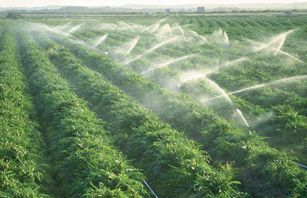What is a Sprinkler Irrigation System?
Sprinkler irrigation is a type of irrigation in which the watering technique is similar to natural rainfall. Water is conveyed through a system of pipes and sprinklers are used to spray the water onto the crops. Sprinklers are basically used to break the water into small droplets. This method of irrigation can be applied to all types of crops.

When to Use Sprinkler Irrigation
- Suitable Slopes: Sprinkler irrigation is compatible with any sort of agricultural land regardless of the slope of the ground. It is recommended to lay the lateral pipes along the natural gradient of the land. This will ensure minimal disruptions to continuous irrigation by maintaining uniform pressure while supplying water to the sprinkles.
- Suitable Crops: This irrigation technique is usually suitable for all crops. However, it should be kept in mind that, larger sprinklers producing bigger droplets of water can damage the delicate crops.
- Suitable Soils: This type of irrigation is appropriate for both sandy and clayey soils. However, soils with high infiltration rates (e.g. sandy soil) are more adaptable to sprinkler irrigation. On the contrary, if the soil has the tendency of crust formation may create interruptions to uniform irrigation. This problem can be overcome by using sprinklers that produce fine droplets of water as bigger droplets aid the formation of crust.
The average rate of applying water (mm/hour) should be chosen carefully. It must be less than the natural infiltration rate of the soil. Otherwise, ponding around the crop roots and runoff can be encountered. - Suitable Irrigation Water: Water quality needs to be checked for efficient irrigation. Usually clean and suspended particle-free water is suitable for sprinkler irrigation. Otherwise, the settlement of particles near sprinkler nozzles will create a blockage, and water supply will be hindered.
Methods of Sprinkler System
Based on the arrangement for spraying irrigation water, sprinkler irrigations are classified into the following two major types -
- Rotating head or revolving sprinkler system:
- This system consists of two types of pipes – riser pipes and lateral pipes. Riser pipes are the vertical pipes with a certain height whereas the lateral pipes are laid on the ground surface.
- The sprinkler nozzles are fixed on the riser pipes mounted on the lateral pipes at uniform intervals.
- A system of pipes network consisting of main and sub-main conveys water from the source of water to the laterals.
- The pump is used to carry water from main to sub-main and from sub-main to lateral pipes under pressure.
- To irrigate a rectangular strip of land, sprinkler heads are mounted on risers in a way that they are at a sufficient height above the crop and rotated through 90o to 350o.
- A small hammer activated by the thrust of water striking against a connected vane is used to rotate the sprinkler heads.
- The pressure and application rate are kept between 2 – 4 kg/cm2 and 4 – 20 mm/hr respectively.
Fig.: Example of a few rotating type sprinkler irrigation
- Perforated pipe system:
- Here, holes are drilled on the nozzles along the length of the pipes. Through these holes, water is sprayed on the crops under pressure.
- The pressure is usually kept as low as 1 kg/cm2.
- The application rate varies between 1.35 – 5 cm/hr depending on the pressure and spacing of sprinklers.
Fig: Plan view (sprinkler irrigation method)
Based on the portability, sprinkler irrigations are classified into the following types -
- Portable system: A portable system, as the name suggests, consists of potable mains, sub mains, laterals, and portable pumping units. These portable networks can be transferred from farm to farm. However, moving the whole set-up can be labor-intensive and requires great care while handling all the components. The initial cost of setting up this system is comparatively less than the others.
- Semi portable system: Here, all the components are portable to expect the water source and pumping unit to be fixed. The movable parts can be taken to other fields only if there is an extended mainline and additional pumping unit.
- Semi-permanent system: In a semi-permanent method, lateral lines are portable whereas mains, sub mains, water source, and pumping units are permanent. The mains and sub mains are buried into the ground.
- Solid set system: This method of irrigation profitable when the crops require frequent irrigation at a small depth. In a solid set technique, laterals are kept in a fixed position for a minimum of one crop season. Before the beginning of a crop season, the laterals are positioned and kept there for the entire crop season. This technique is mostly adopted when the frequent movement of laterals is not required.
- Permanent system: This type of setup is expensive and most suitable for an automatic system. It consists of buried mains, sub mains and stationary pumping units, and source of water. The components do not interfere with the firming works. Example: Orchard irrigation.

